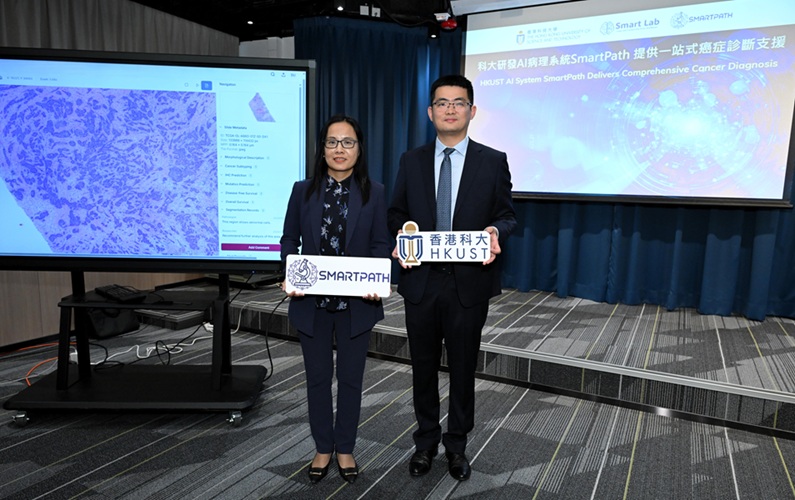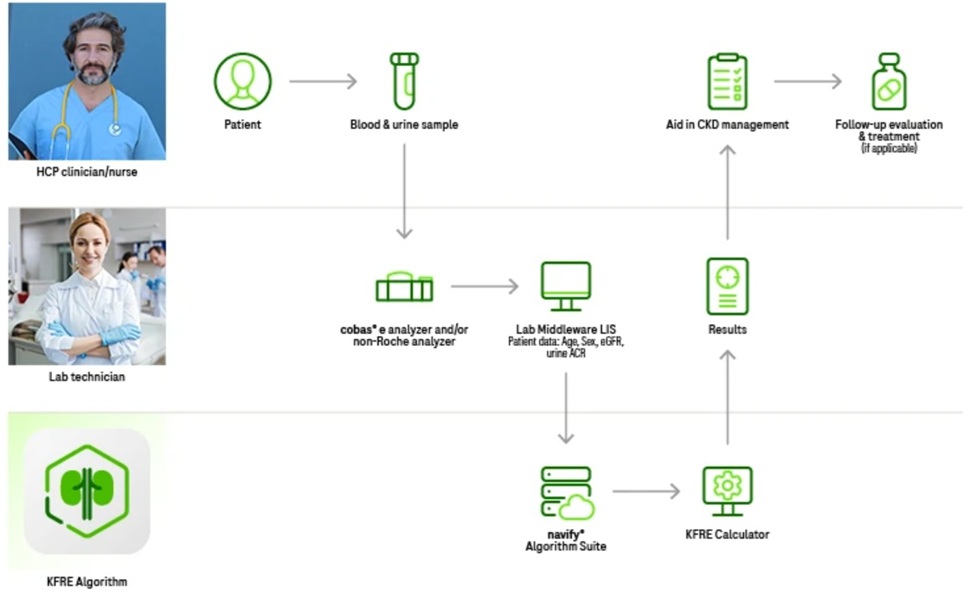Photochemical Internalization Cancer Treatment with Minor Side Effects Closer to Reality
|
By LabMedica International staff writers Posted on 24 Jan 2012 |
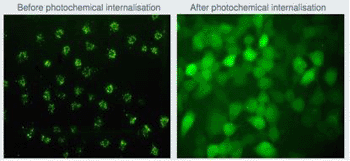
Image: Light-sensitive molecules (orange) before and after photochemical internalization (PCI) treatment. At left, the molecules are trapped within membranes inside the cancer cell. At right, the molecules have been released and can spread--along with the cytotoxic drugs--throughout the entire cancer cell (Photo courtesy of Pål K. Selbo/PCI Biotech).
Side effects are currently the biggest drawback with any cancer treatment. A Norwegian biotech company is getting closer to creating a treatment that destroys only cancer cells, leaving other cells unaffected.
It is not hard to find a drug that destroys cancer cells. The problem lies in the fact that a drug’s active compounds kill indiscriminately, not only diseased cells die but also other cells in the body. This is why the side effects associated with conventional cancer treatment are frequently so severe.
The hope of any cancer researcher is to develop a drug that works only against a cancerous tumor--without adversely affecting the rest of the body. This objective can be attained in two ways: one is to produce targeted drugs that affect only the cancer cells; the other is to design smarter way of delivering a drug to its target without affecting other parts of the body.
A biotech company, PCI Biotech Holding, ASA (Lysaker, Norway), has been focusing on the latter approach since 2000. Researchers working on the project Fotokjemisk internalisering for Cellegiftterapi av Kreft (Photochemical Internalization of Chemotherapy) have steadily been getting closer to a solution. Headed by chief scientific officer Dr. Anders Høgset, the project has received funding under the Program for User-driven Research-based Innovation (BIA) at the Research Council of Norway.
The technology is based on light and is called photochemical internalization (PCI). It was discovered in 1994 at the Norwegian Radium Hospital in Oslo (now part of Oslo University Hospital). PCI Biotech uses the technology to direct a red laser to the area of the body where the drug is to have its effect. The light significantly enhances drug delivery to specific locations inside the diseased cells.
“But in order to achieve the desired effect from the light, we need to give the patient a photosensitizing compound,” explained Dr. Høgset. “This is a chemical substance increasing cells’ sensitivity to light. We have created and patented a molecule [Amphinex] that we inject into a patient and let circulate for a few days. Then we give the patient the desired drug. After a short while, we shine the laser on the tumor where both Amphinex and the medication are now present. When light is applied, Amphinex triggers processes within the cancer cells, substantially enhancing the effect of the drug.”
The challenge of effectively transporting molecules to a targeted area inside a cell has long stumped cancer researchers. For pharmaceutical companies, it has created a logjam, slowing down further development of a number of molecules with great therapeutic possibilities.
Patients have often had to receive higher doses of a drug than what would otherwise be necessary had there existed a way to target drug delivery to the right location inside a cell. Because of these higher doses, the side effects patients experience are commensurately more severe. “Now we have finally succeeded in finding a way to deliver cancer medications inside the malignant cells, destroying them effectively,” noted Dr. Høgset.
These cancer-killing medications pass through cancer cell membranes much more easily, which considerably increases their accuracy. It follows that doses can be reduced substantially with side effects becoming correspondingly less severe. “In the laboratory, we have managed to enhance the effect of some cytotoxic drugs by a full 50 times. We did so by administering Amphinex and directing light to the cancer cell,” explained Dr. Høgset.
PCI Biotech, together with University College London Hospital, began performing research on human subjects two years ago. “All patients involved in the study experienced a considerable effect from the light treatment and, in most cases, the treated tumors disappeared altogether. No serious side effects were observed,” said Dr. Høgset.
PCI Biotech is now going to follow-up with additional clinical research. Up to the present, PCI Biotech has focused on localized cancer treatment, for example, for mouth cancer, breast cancer, and facial skin cancer. Many cancer patients stand to benefit greatly from localized treatment, but a great number also require treatment that can attack cancer that has metastasized to other areas of the body.
As part of a future project, PCI Biotech intends to extend its technology to treatment of metastatic cancer. The project will evaluate whether the technology can activate a person’s immune system, enabling it to attack cancer cells in more than one part of the body.
Related Links:
PCI Biotech Holding
It is not hard to find a drug that destroys cancer cells. The problem lies in the fact that a drug’s active compounds kill indiscriminately, not only diseased cells die but also other cells in the body. This is why the side effects associated with conventional cancer treatment are frequently so severe.
The hope of any cancer researcher is to develop a drug that works only against a cancerous tumor--without adversely affecting the rest of the body. This objective can be attained in two ways: one is to produce targeted drugs that affect only the cancer cells; the other is to design smarter way of delivering a drug to its target without affecting other parts of the body.
A biotech company, PCI Biotech Holding, ASA (Lysaker, Norway), has been focusing on the latter approach since 2000. Researchers working on the project Fotokjemisk internalisering for Cellegiftterapi av Kreft (Photochemical Internalization of Chemotherapy) have steadily been getting closer to a solution. Headed by chief scientific officer Dr. Anders Høgset, the project has received funding under the Program for User-driven Research-based Innovation (BIA) at the Research Council of Norway.
The technology is based on light and is called photochemical internalization (PCI). It was discovered in 1994 at the Norwegian Radium Hospital in Oslo (now part of Oslo University Hospital). PCI Biotech uses the technology to direct a red laser to the area of the body where the drug is to have its effect. The light significantly enhances drug delivery to specific locations inside the diseased cells.
“But in order to achieve the desired effect from the light, we need to give the patient a photosensitizing compound,” explained Dr. Høgset. “This is a chemical substance increasing cells’ sensitivity to light. We have created and patented a molecule [Amphinex] that we inject into a patient and let circulate for a few days. Then we give the patient the desired drug. After a short while, we shine the laser on the tumor where both Amphinex and the medication are now present. When light is applied, Amphinex triggers processes within the cancer cells, substantially enhancing the effect of the drug.”
The challenge of effectively transporting molecules to a targeted area inside a cell has long stumped cancer researchers. For pharmaceutical companies, it has created a logjam, slowing down further development of a number of molecules with great therapeutic possibilities.
Patients have often had to receive higher doses of a drug than what would otherwise be necessary had there existed a way to target drug delivery to the right location inside a cell. Because of these higher doses, the side effects patients experience are commensurately more severe. “Now we have finally succeeded in finding a way to deliver cancer medications inside the malignant cells, destroying them effectively,” noted Dr. Høgset.
These cancer-killing medications pass through cancer cell membranes much more easily, which considerably increases their accuracy. It follows that doses can be reduced substantially with side effects becoming correspondingly less severe. “In the laboratory, we have managed to enhance the effect of some cytotoxic drugs by a full 50 times. We did so by administering Amphinex and directing light to the cancer cell,” explained Dr. Høgset.
PCI Biotech, together with University College London Hospital, began performing research on human subjects two years ago. “All patients involved in the study experienced a considerable effect from the light treatment and, in most cases, the treated tumors disappeared altogether. No serious side effects were observed,” said Dr. Høgset.
PCI Biotech is now going to follow-up with additional clinical research. Up to the present, PCI Biotech has focused on localized cancer treatment, for example, for mouth cancer, breast cancer, and facial skin cancer. Many cancer patients stand to benefit greatly from localized treatment, but a great number also require treatment that can attack cancer that has metastasized to other areas of the body.
As part of a future project, PCI Biotech intends to extend its technology to treatment of metastatic cancer. The project will evaluate whether the technology can activate a person’s immune system, enabling it to attack cancer cells in more than one part of the body.
Related Links:
PCI Biotech Holding
Latest BioResearch News
- Genome Analysis Predicts Likelihood of Neurodisability in Oxygen-Deprived Newborns
- Gene Panel Predicts Disease Progession for Patients with B-cell Lymphoma
- New Method Simplifies Preparation of Tumor Genomic DNA Libraries
- New Tool Developed for Diagnosis of Chronic HBV Infection
- Panel of Genetic Loci Accurately Predicts Risk of Developing Gout
- Disrupted TGFB Signaling Linked to Increased Cancer-Related Bacteria
- Gene Fusion Protein Proposed as Prostate Cancer Biomarker
- NIV Test to Diagnose and Monitor Vascular Complications in Diabetes
- Semen Exosome MicroRNA Proves Biomarker for Prostate Cancer
- Genetic Loci Link Plasma Lipid Levels to CVD Risk
- Newly Identified Gene Network Aids in Early Diagnosis of Autism Spectrum Disorder
- Link Confirmed between Living in Poverty and Developing Diseases
- Genomic Study Identifies Kidney Disease Loci in Type I Diabetes Patients
- Liquid Biopsy More Effective for Analyzing Tumor Drug Resistance Mutations
- New Liquid Biopsy Assay Reveals Host-Pathogen Interactions
- Method Developed for Enriching Trophoblast Population in Samples
Channels
Clinical Chemistry
view channel
VOCs Show Promise for Early Multi-Cancer Detection
Early cancer detection is critical to improving survival rates, but most current screening methods focus on individual cancer types and often involve invasive procedures. This makes it difficult to identify... Read more
Portable Raman Spectroscopy Offers Cost-Effective Kidney Disease Diagnosis at POC
Kidney disease is typically diagnosed through blood or urine tests, often when patients present with symptoms such as blood in urine, shortness of breath, or weight loss. While these tests are common,... Read moreMolecular Diagnostics
view channel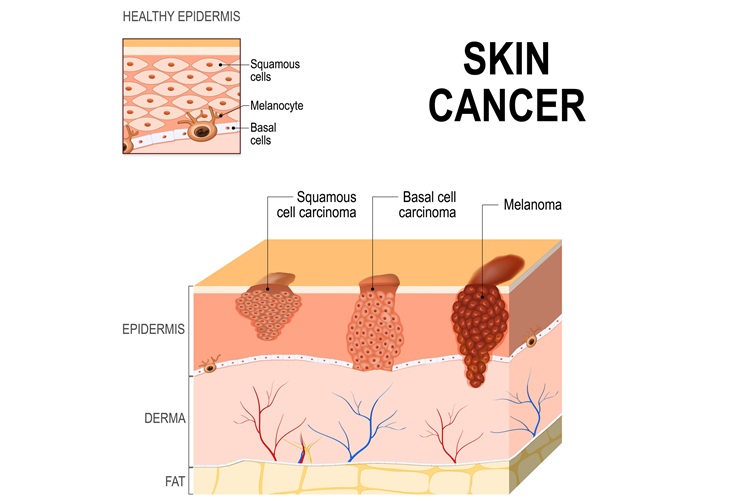
Genomic Test Could Reduce Lymph Node Biopsy Surgery in Melanoma Patients
Accurately determining whether melanoma has spread to the lymph nodes is crucial for guiding treatment decisions, yet the standard procedure—sentinel lymph node biopsy—remains invasive, costly, and unnecessary... Read more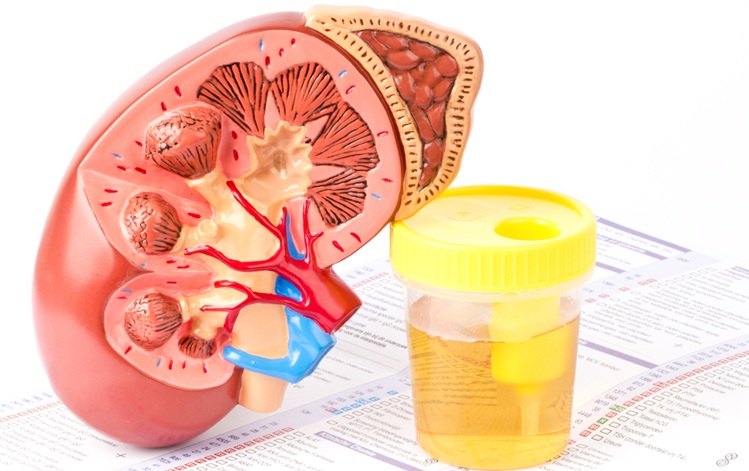
Urine Test Could Replace Painful Kidney Biopsies for Lupus Patients
Lupus is an autoimmune disorder that causes the immune system to attack the body’s own tissues and organs. Among the five million people living with lupus globally, nearly half develop lupus nephritis,... Read more
Blood Test Guides Post-Surgical Immunotherapy for Muscle-Invasive Bladder Cancer
After surgery for muscle-invasive bladder cancer, many patients face uncertainty about whether residual cancer cells remain in their bodies. Now, a new international phase 3 study has demonstrated that... Read more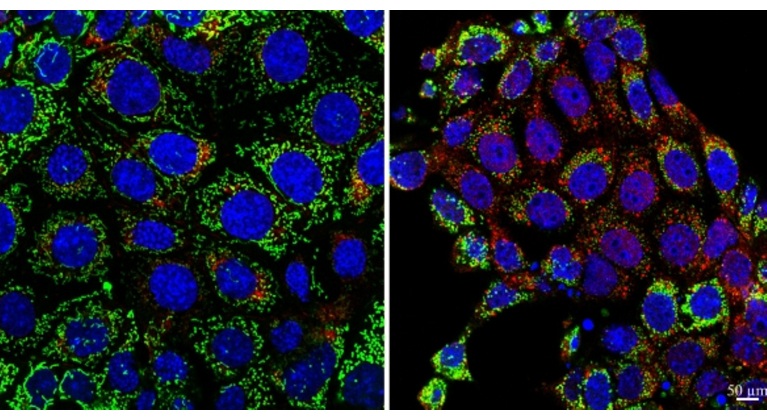
Mitochondrial DNA Mutations from Kidney Stressors Could Predict Future Organ Decline
Kidney-related diseases are alarmingly common: chronic kidney disease (CKD) affects more than one in seven U.S. adults, while about 20% of hospitalized adults are diagnosed with acute kidney injury (AKI).... Read moreHematology
view channel
Viscoelastic Testing Could Improve Treatment of Maternal Hemorrhage
Postpartum hemorrhage, severe bleeding after childbirth, remains one of the leading causes of maternal mortality worldwide, yet many of these deaths are preventable. Standard care can be hindered by delays... Read more
Pioneering Model Measures Radiation Exposure in Blood for Precise Cancer Treatments
Scientists have long focused on protecting organs near tumors during radiotherapy, but blood — a vital, circulating tissue — has largely been excluded from dose calculations. Each blood cell passing through... Read more
Platelets Could Improve Early and Minimally Invasive Detection of Cancer
Platelets are widely recognized for their role in blood clotting and scab formation, but they also play a crucial role in immune defense by detecting pathogens and recruiting immune cells.... Read more
Portable and Disposable Device Obtains Platelet-Rich Plasma Without Complex Equipment
Platelet-rich plasma (PRP) plays a crucial role in regenerative medicine due to its ability to accelerate healing and repair tissue. However, obtaining PRP traditionally requires expensive centrifugation... Read moreImmunology
view channel
Blood-Based Liquid Biopsy Model Analyzes Immunotherapy Effectiveness
Immunotherapy has revolutionized cancer care by harnessing the immune system to fight tumors, yet predicting who will benefit remains a major challenge. Many patients undergo costly and taxing treatment... Read more
Signature Genes Predict T-Cell Expansion in Cancer Immunotherapy
Modern cancer immunotherapies rely on the ability of CD8⁺ T cells to rapidly multiply within tumors, generating the immune force needed to eliminate cancer cells. However, the biological triggers behind... Read moreMicrobiology
view channel
Fast Noninvasive Bedside Test Uses Sugar Fingerprint to Detect Fungal Infections
Candida bloodstream infections are a growing global health threat, causing an estimated 6 million cases and 3.8 million deaths annually. Hospitals are particularly vulnerable, as weakened patients after... Read more
Rapid Sepsis Diagnostic Device to Enable Personalized Critical Care for ICU Patients
Sepsis is a life-threatening condition that occurs when the body’s response to infection spirals out of control, damaging organs and leading to critical illness. Patients often arrive at intensive care... Read morePathology
view channel
Tears Offer Noninvasive Alternative for Diagnosing Neurodegenerative Diseases
Diagnosing and monitoring eye and neurodegenerative diseases often requires invasive procedures to access ocular fluids. Ocular fluids like aqueous humor and vitreous humor contain valuable molecular information... Read more
AI-Powered Method Combines Blood Data to Accurately Measure Biological Age
Chronological age tells us how many years we’ve lived, but not how quickly our bodies are ageing. Some people stay healthy well into their 80s or 90s, while others experience decline much earlier.... Read moreTechnology
view channel
Embedded GPU Platform Enables Rapid Blood Profiling for POC Diagnostics
Blood tests remain a cornerstone of medical diagnostics, but traditional imaging and analysis methods can be slow, costly, and reliant on dyes or contrast agents. Now, scientists have developed a real-time,... Read more
Viral Biosensor Test Simultaneously Detects Hepatitis and HIV
Globally, over 300 million people live with Hepatitis B and C, and 40 million with HIV, according to WHO estimates. Diagnosing bloodborne viruses such as HIV and Hepatitis B and C remains challenging in... Read moreIndustry
view channel
Advanced Instruments Merged Under Nova Biomedical Name
Advanced Instruments (Norwood, MA, USA) and Nova Biomedical (Waltham, MA, USA) are now officially doing business under a single, unified brand. This transformation is expected to deliver greater value... Read more

















